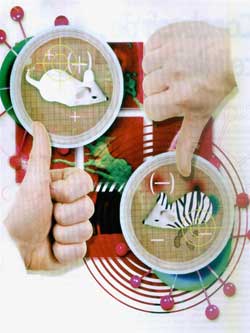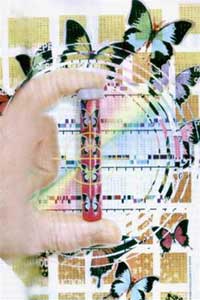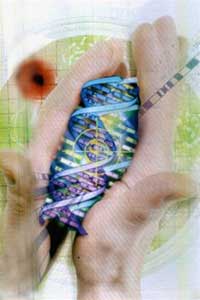 A heavy fever is spreading through many laboratories worldwide, infecting biologists, physicists, chemists, and computer specialists.
A heavy fever is spreading through many laboratories worldwide, infecting biologists, physicists, chemists, and computer specialists.
Symptoms: The desire to recreate life in a test tube or on a computer, to create a living organism from inert chemical components, or to “stir” life to produce… new organisms! This fever is called synthetic biology!
Do not confuse synthetic biology with prebiotic chemistry, which seeks to create the first living entities by mixing the simplest molecules in a “soup.” It is also different from artificial life in the 1970s, which aimed to make machines smarter.
While borrowing techniques from classical genetic manipulation, synthetic biology is vastly different, with greater ambitions and more complex applications. With this new field, biology has stepped into the realm of “design.” Biologists are no longer just explorers of life’s structures; they are also using it as a means to enhance humanity’s control over the universe. Professor Theodor von Karman once said: “Scientists discover what exists; engineers create unprecedented organisms!”
Reprogramming Microbes!
These are engineers, computer specialists, chemists, biologists, etc. They want to understand and control nature. They believe that life is a program encoded in DNA molecules. Altering or rewriting this code will compel nature to do what humanity has never achieved, even what nature has not accomplished! They are aggressively attacking various microbes using a technique called reprogramming.
In 2000, Michael Elowitz and Stanislas Leibler from the Molecular Biology Department at Princeton University, USA, turned the dull-colored bacterium Escherichia coli into a bright… blinking organism! At the same time, Ron Weiss made it change color based on its environment, turning red in the presence of certain molecules and green when they were absent. Christopher Voigt from the University of California transformed it into… a photographic film! Depending on the intensity of the light, it appears white or black!
In each case, these researchers viewed genes as transistors in an electronic circuit. The nucleic acids A, C, G, T of the DNA molecule replaced the binary code of computers. However, even though they can easily assemble DNA molecules, bacteria do not always produce what the researchers want. Ron Weiss recounted: “It took many years of design to create a system that could operate.”
The field is still evolving. It must standardize gene blocks, eliminate defects, and theorize some results. At the University of California, Berkeley, Jay Keasling plans to synthesize an anti-malaria molecule within the bacterium artemisinin, which is difficult to produce artificially. Christopher Voigt is creating a bacterium that can “smell” cancer.
Others dream of creating bacteria that can detoxify pollutants and environmental toxins. Ron Weiss concludes: “We are in a phase similar to the early days of computers. The applications are unpredictable.”
Creating Viruses
 Genetics allows for more than just altering a few genes of a bacterium. It can splice individual genes and create life for a virus. For instance, in 2002, Eckard Wimmer’s team at New York University created a poliovirus from a simple gene sequence at Stony Brook Laboratory. They assembled 7,500 bases of a DNA molecule, akin to threading beads to make a necklace.
Genetics allows for more than just altering a few genes of a bacterium. It can splice individual genes and create life for a virus. For instance, in 2002, Eckard Wimmer’s team at New York University created a poliovirus from a simple gene sequence at Stony Brook Laboratory. They assembled 7,500 bases of a DNA molecule, akin to threading beads to make a necklace.
When outside a cell, this artificial virus has no effect, but it causes disease identical to that of natural viruses when implanted into a mouse. Eckard Wimmer explained: “We want to demonstrate: a virus is just a chemical, a simple formula! Although polio is considered eradicated, clearly no virus has disappeared completely.” From a sequence of DNA molecules, one can create life for an organism.
This is also what Professor Jeffrey Tautenberg’s team at the U.S. Army Institute of Pathology achieved at the end of 2005. From preserved lung samples of a woman who died during the Spanish flu pandemic in 1918, he recreated the virus that caused the flu, which killed 50 million people at that time.
Both Wimmer and Tautenberg are not biological terrorists. Their goal is merely to unravel the mysteries of viruses to understand their brutal origins, predict their evolution, and, of course, develop vaccines. What better way to recreate a virus than in the laboratory?
Thus, the creators of the Spanish flu can trace the virus’s origins, likely also avian, but different from the H5N1 virus that is currently rampant worldwide. Moreover, Eckard Wimmer plans to use these synthetic organisms to combat diseases such as West Nile fever or meningitis.
These two pioneering research teams will undoubtedly “stir things up” as it becomes increasingly easier to synthesize larger genes. In 2002, creating the poliovirus took a year. Now it only takes a few weeks! In 2003, American biologist Craig Venter synthesized 5,000 bases of a virus capable of eliminating bacteria in just 14 days.
Since then, records have been continuously broken. By the end of 2004, at Harvard University, Professor George Church’s team had spliced together 14,500 bases for a DNA molecule. All equivalent to amino acids in proteins. Simultaneously, a research group from American company Kosan Bioscience synthesized a DNA molecule from 32,000 bases, one of the proteins of the bacterium E. Coli!
Finally, in 2005, George Church connected a DNA molecule containing up to 10 million bases. However, the error rate was ten times higher than in his previous experiment! In summary: the complete genetic code with 4.7 million bases of the bacterium Escherichia coli is seen as within the “assembly” reach of researchers.
In December 2005, the American magazine Wired listed 20 biological facilities, including: DNA 2.0, Blue Heron, Codon Devices, Integrated DNA… Jeremy Minshull, the head of DNA 2.0, which was founded three years ago, stated: “In 2003, the price of a basic base pair to create a DNA molecule ranged from $5-8. Now it’s $1-3.”
George Church predicts: “The Codon Device company I founded will be beneficial for a wide range of biotechnology, chemical, and pharmaceutical enterprises. We are equivalent to Microsoft or IBM in the field of biology.”
The Minimal Genome for Life
How many genes does life minimally need to exist? This question has been posed by American biologist Craig Venter for many years. After participating in decoding the largest genome: humans, he returned to his initial passion of pursuing bacteria. The goal: to determine the minimum number of genes that a living organism must have to survive. This research topic itself is a significant event.
Mycoplasma genitalium is a “resident” of the planet that only needs 517 genes to ensure it is a living organism: moving, eating, reproducing, etc. However, not all genes need to be complete, and the researcher only needs to assemble about 250. From this basic gene reserve, Craig Venter aspires to introduce new genes that allow the production of hydrogen gas or the absorption of CO2 from the greenhouse effect.
In reality, life is a very relative issue and closely related to the surrounding environment. A minimal organism operating at 37°C may not survive at 40°C, as it lacks certain tool genes to adapt to environmental changes.
Thus, believing that humans are defined solely by a genetic code overlooks the tens of thousands of other microorganisms in the body that supplement essential needs for life. Dusko Ehrlich clarifies: “Each individual has thousands of different organisms within their body. The number of microbial cells in the body is ten times greater than our actual cells. If an extraterrestrial were to observe us, they would be amazed to see the microorganisms living in the human body warmly and intelligently.”
Artificial Cells
 Without machinery, a computer program cannot run. Life is the same. The genetic program can only run if there is a platform. This platform is the cell, surrounded by a membrane that can interact with the outside.
Without machinery, a computer program cannot run. Life is the same. The genetic program can only run if there is a platform. This platform is the cell, surrounded by a membrane that can interact with the outside.
In 2005, Albert Libchaber, a French researcher at Rockefeller University, New York, created proteins from within the cell, which then moved to the membrane to act as a channel for communication between the inside and outside. The effect was immediately visible. The cell lived longer by absorbing food from the outside and expelling waste from within. It survived for several days, compared to a few hours without the communication channel.
As for “programming” the life machine to move, we see that it is becoming increasingly easier to write. The DNA molecule here consists of less than 10,000 basic bases.
However, to create life, many other factors are needed: enzymes to stimulate reactions; amino acids to serve as building blocks, and ribosomes to connect amino acids… Although complex, researchers have a clear understanding of this formula.
Depending on the perspective of each research group, they target different applications. Mark Bedau, founder of ProtoLife, states: “Artificial life forms can be used to process environmental pollution. They can consume what is toxic to us. Cells can be viewed as mini-factories, producing what humans cannot, such as hydrogen.” Mark Bedau confidently asserts: “When will an artificial cell be born? Not far off!” This American researcher’s optimism is beginning to spread across Europe.
Creating Monsters?
Life’s diversity in nature is not chaotic. On the contrary, all microbes, plants, and animals in the universe are formed from basic building blocks. These are approximately 20 fundamental amino acids. Therefore, researchers wonder: is it possible to conceive life using “other types of bricks”? Peter Schultz from the Scripps Research Institute in California states: “Although a code with 20 amino acids is sufficient to create life, it may not be the best.”
Leading this field, in 2000, his team demonstrated that an organism like a bacterium could insert itself into the process of amino acid production, which is not its nature. Since then, this group has “genetically encoded” over 30 other amino acids. These are strange molecules that can glow or carry heavy atoms… never before seen in the universe!
These monsters are still in their embryonic stage. However, the future benefits are enormous. Researchers are thinking of amino acids carrying therapeutic molecules such as polyethylene glycol to enhance the efficacy of many drugs. Another group is studying the creation of biopolymer substances from protein clusters in test tubes. Some teams aim to develop bacteria capable of detoxifying soil to clean up the environment and produce hydrogen gas…
Theoretically, deploying genetic codes not only allows us to reach the origins of life on Earth but also helps us understand the forms of life beyond the universe. One thing is certain, if other life exists in the universe, it will share a language with us.
Parallel Evolution of Digital Technology
 It is not necessary to manipulate genes and molecules to understand the secrets of life. With the advancement of computers, manipulating data, such as environmental factors, can reveal the common dynamics of an evolutionary process that remains very mysterious.
It is not necessary to manipulate genes and molecules to understand the secrets of life. With the advancement of computers, manipulating data, such as environmental factors, can reveal the common dynamics of an evolutionary process that remains very mysterious.
It is “more mobile” than a biologist in a laboratory, as modern computing power can create hundreds of generations of evolution in a space of just one minute! And the results are astonishing to researchers.
Chris Amadi, director of the Life Digital Laboratory at Caltech, California, has developed Avida, a program with virtual organisms called Avidiens. Microsoft has sponsored this laboratory.
*** *** ***
Is creating life dangerous? Synthetic biology is advancing, while also bringing social, environmental, and ethical consequences.
In June 2005, a bioethics committee was established in the United States, involving philosophers and anthropologists. Thirty-two years earlier, in 1974, the Asilomar Committee was formed to set safety standards for genetic engineering experiments, monitoring the dangers of biological techniques to alert the world before it is too late…
DINH CONG THANH (Science & Avenir 3-2006)


















































